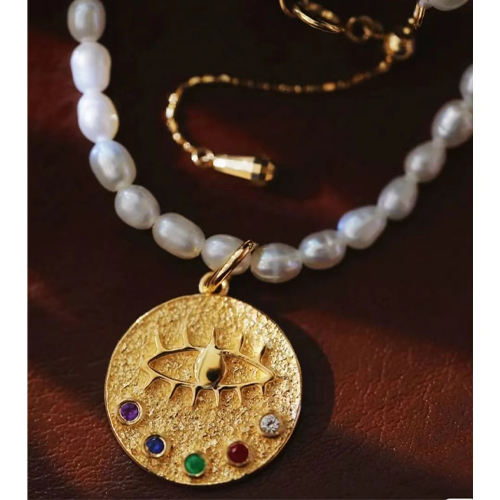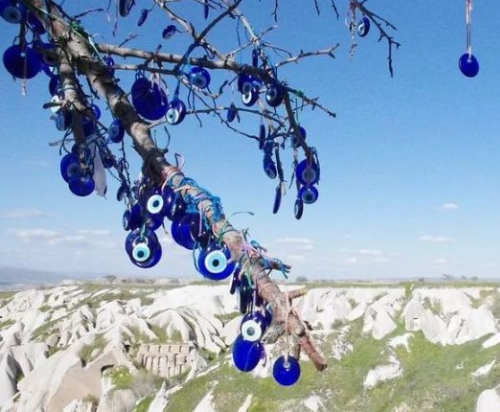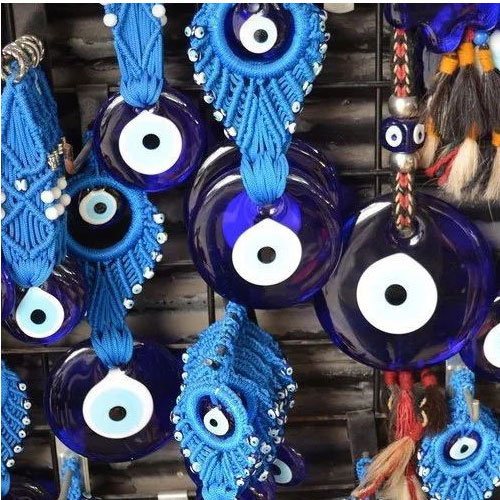
A smaller piece of light blue glass embed in a more significant blue glass, and a small black glass block in the shape of a "black eyeball" embed in the light blue glass. The Turks call "Nazar," and the Chinese call it "blue eyes." People like "blue eyes" and think they can absorb evil energy for the owner, but they should replace them frequently because the lousy energy will overflow and hinder the owner.
Why is this "blue eye" so prevalent in Turkey? It is related to the mythological origin of Turkey.
According to Yıldıran, a professor of art history at Turkey's Bahçeşehir University, the blue eyes famous in Turkey today may have originated in Egypt. Any superstitious culture in the world is inseparable from the background of mythology, and blue eyes are no exception to the Egyptian god Horus.
The Blue Eye
Devil's Eye has many origins, among which the story of the "Eye of Medusa" is widely circulated. According to legend, in Greek mythology, Athena attached Medusa's head to her armor, thus gaining the ability to petrify Medusa's eyes. In the subsequent battles, Athena was invincible and unbeatable. Therefore it is achieving the glory of Athena again.
The petrified eyes of Medusa have since become a symbol of protection and peace. The locals made similar eyes, believing that the eyes of Medusa could ward off evil gods, "fight poison with poison," and bring good luck. A legend says Seth takes away Horus's left eye in the fight.

Horus' eyes are unusual, and the left eye represents the moon. With the help of the moon god, after a desperate struggle, the god Horus finally defeated Seth and recaptured the left Eye. Later, the Eye of Horus became a talisman that discerns good from evil, defends health and happiness, and has the power to defeat the evil gaze. It is a kind of amulet with extraordinary magic power, which was most commonly used as an amulet to ward off evil spirits by the ancient Egyptians.
The locals believe that being stared at by the evil god will bring bad luck, so they always wear a blue eye-shaped amulet that imitates the devil's Eye to attract the attention of the evil god and avoid bad luck, so blue eyes are a Turkish tradition. It is also the favorite amulet and mascot of the Turks.
In Turkey, there are many legends about "blue eyes," and the above statement is only one of them, but no matter what the process of the mythology is, "blue eyes" eventually came to the end of "exorcism" and "talisman."
Turks have believed in "blue eyes" for a long time. Legend has it that once a rich man stared at a fat cow passing by his door, he said to his wife: "Today, I have not seen anything more beautiful than this fat cow." The fat cow stared at the rich man. He fell to the ground and died, and his wife cut off the fat beef and took it home. People refer to the eyes of the rich man in the story as the "jealous look," believing that this look has a vast "terrifying power" that kills the cow.

Turks concluded that the most vulnerable to "jealous eyes" are children, beautiful women, and people who stand out in society because children are weak, and beauty and success are easily envy. The Turks chose " blue eyes " to protect themselves from "jealous eyes" and the Turks chose "blue eyes." Locals said that "blue eyes" can attract "jealous eyes," and when the "blue eyes" burst open, it means that the disaster has been resolved, thus protecting people from harm.
In the Asian part of Turkey, Anatolia, the concept that "blue eyes" can "ward off evil spirits" is still prevalent. If a sturdy and beautiful child dies, or a sturdy animal in the family suddenly dies of illness, the locals attribute the cause to "jealous eyes." To "ward off evil spirits," people usually place "blue eyes" in the places where they think "jealous eyes" are most likely to appear, such as the door of the house, the backyard, the shoulders of children, and the forehead of cows, etc.
Turkey's "blue eye" processing workshops mostly located in the countryside. According to traditional techniques, artisans build circular or oval kilns with fired bricks and clay on flat ground and then paste them into horseshoe shapes with clay. The temperature when firing glass is as high as 800-1200 degrees Celsius, so the service life of this kind of kiln is only one year.
The "blue eye" kiln is general dividing into several parts: the part that melts the glass is called "Tava," the amount that burns the wood containing pine resin is called "capac", and the claim used for cooling after the "blue eye" made is called "Kavala." " Each kiln also has two or three small holes for extracting the glass melt.
When making it, craftsmen generally use an iron rod with a length of 50-60 cm to take out the glass melt from the "tava", place it in a broader iron plate, and then beat it with a steel rod with a length of 30-40 cm, shape and finally use a thin steel rod to add black "eyeballs" to the shaped glass block. In this way, a "blue eye" is done.
The workshops that make "blue eyes" generally purchase transparent glass directly from glass factories. The raw materials such as purple, brown, green, and red glass needed in production obtained from the purchased waste.
An old craftsman in Turkey said to me: "The light blue part of the 'blue eye' should be yellow so that the effect of 'repelling evil' is better." It became a popular fashion
"Blue eyes" has become inseparable from the lives of Turks. Not only do they hang "blue eyes" at significant ceremonies such as weddings and funerals to pray for the protection of the gods, but in regular times, many people put small "blue eyes" in their chest pockets.
On the ground of Cappadocia, the bare trees are covered with "blue eyes," forming a strange and beautiful landscape, which also represents the awe of the Turks for the mysterious power of heaven and earth and the unknown world.

Today, "blue eyes" are more common wherever they go and have gradually evolved from "evil wardens" to Turkish fashion jewelry. Many people put their little "blue eyes" in their breast pockets on ordinary days.
Savvy businessmen also designed jewelry or souvenirs with "blue eyes," such as exquisite bracelets, bracelets, earrings, rings, head flowers, necklace pendants, key chains, etc. And "blue eyes" are no longer only blue. Red, yellow, and green "eyes" came into being with people's needs. In terms of materials, in addition to traditional glass, there are more kinds of gold, silver, crystal, wood, etc.

Ordinary glass "blue eyes" can be bought for only a few dollars. Many tourists who buy "blue eyes" not only want to bring back commemorative and exquisite gifts to their families but also wish to send their heartfelt blessings to their loved ones.
The blue-eyed culture is an essential part of many ancient cultures in Turkey. It is the witness of the Turkish civilization that has spanned a long time and is one of Turkey's profound charm elements.
Contact: Lee
Phone: 008615812571762
E-mail: le@lerings.com
Whatsapp:008615812571762
Add: 3F,#4 ShangXing Road, XingAn ChangAn Town, DongGuan,China
We chat